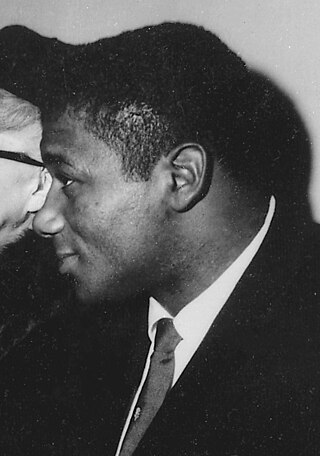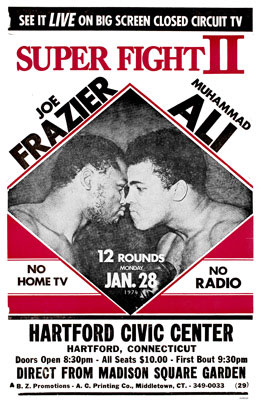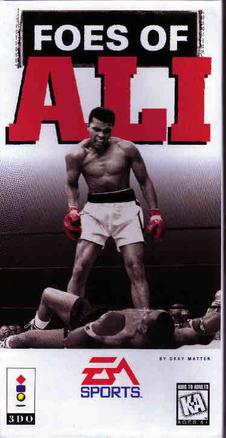
Boxing is a combat sport and a martial art in which two people, usually wearing protective gloves and other protective equipment such as hand wraps and mouthguards, throw punches at each other for a predetermined amount of time in a boxing ring.

Knockout Kings was a series of boxing video games produced by EA Sports for various platforms yearly between 1998 and 2003.

George Edward Foreman is an American former professional boxer, entrepreneur, minister, and author. In boxing, he competed between 1967 and 1997 and was nicknamed "Big George". He is a two-time world heavyweight champion and an Olympic gold medalist. As an entrepreneur, he is known for the George Foreman Grill.

Joseph William Frazier, nicknamed "Smokin' Joe", was an American professional boxer who competed from 1965 to 1981. Widely regarded as one of the greatest heavyweight boxers of all time, he was known for his strength, durability, formidable left hand, and relentless pressure fighting style and was the first boxer to defeat Muhammad Ali. Frazier won a gold medal at the 1964 Summer Olympics as an amateur, held the NYSAC heavyweight title from 1968 to 1973, and was the undisputed heavyweight champion from 1970 to 1973.

Kenneth Howard Norton Sr. was an American professional boxer who competed from 1967 to 1981. He was awarded the WBC world heavyweight championship in 1978, after winning a close split decision over Jimmy Young in a title eliminator bout, after which Leon Spinks refused to fight with him.

Floyd Patterson was an American professional boxer who competed from 1952 to 1972, and twice reigned as the world heavyweight champion between 1956 and 1962. At the age of 21, he became the youngest boxer in history to win the title, and was also the first heavyweight to regain the title after losing it. As an amateur, he won a gold medal in the middleweight division at the 1952 Summer Olympics. He has been named among the top 15 heavyweights of all time.

Earnie Dee Shaver, best known as Earnie Shavers, was an American professional boxer who competed between 1969 and 1995. A two-time world heavyweight championship challenger, he is known as one of the hardest punchers in heavyweight boxing history. He scored 70 knockout wins, including 23 in the first round, for a 76.7% overall knockout rate.
Jerry Quarry, nicknamed "Irish" or "The Bellflower Bomber", was an American professional boxer. During the peak of his career from 1968 to 1971, Quarry was rated by The Ring magazine as the most popular fighter in the sport. His most famous bouts were against Muhammad Ali. He is regarded as being one of the best heavyweight boxers never to win a title. He beat former world heavyweight champion Floyd Patterson and top contenders Ron Lyle, Earnie Shavers, Brian London, Thad Spencer, Buster Mathis, Randy Neumann, Jack Bodell, Mac Foster and Eduardo Corletti. He accumulated damage from lack of attention to defense against larger men at the top level, no head guard sparring, and attempted comebacks in 1977, 1983 and 1992 resulted in Quarry developing an unusually severe case of dementia pugilistica.

Bare-knuckle boxing is a full-contact combat sport based on punching without any form of padding on the hands. The sport as it is known today originated in 17th-century England and differs from street fighting as it follows an accepted set of rules.

Muhammad Ali vs. Joe Frazier II, billed as Super Fight II, was a professional boxing match contested on January 28, 1974, for the NABF heavyweight title. The second of the three Ali–Frazier bouts, it took place at Madison Square Garden in New York City.

Boxing Legends of the Ring is a boxing video game for the Mega Drive/Genesis and Super NES consoles. The boxers are represented by 2D sprites seen from over the shoulder of one of the fighters. The title of the game refers to the famous boxing magazine, The Ring, which the game is licensed to associate itself with. The following famous middleweight boxers are represented in the game: Sugar Ray Leonard, Roberto Durán, Thomas Hearns, James Toney, Marvin Hagler, Jake LaMotta, Sugar Ray Robinson, and Rocky Graziano.

Throughout the history of gloved boxing styles, techniques and strategies have changed to varying degrees. Ring conditions, promoter demands, teaching techniques, and the influence of successful boxers are some of the reasons styles and strategies have fluctuated.

Riddick Bowe Boxing is a multiplatform boxing video game released in 1993. It was also released for the Game Boy and Game Gear consoles.

Foes of Ali is a boxing video game that was developed by Gray Matter and published by EA Sports in 1995. It was released exclusively for the 3DO Interactive Multiplayer console. It was one of the first boxing games to render matches using 3D graphics. Thus, boxers in the game could be shown to move 360 degrees around the ring in a more convincing fashion than had previously been possible using 2D sprites. The gameplay bears many similarities to that featured in 4D Sports Boxing.

Evander Holyfield's "Real Deal" Boxing is a boxing video game that was developed by ACME Interactive and published by Sega in 1992, released for the Mega Drive/Genesis and Game Gear consoles. It was followed by a sequel in 1993, Greatest Heavyweights, which featured a number of improvements.

Greatest Heavyweights is a boxing video game that was published by Sega in 1993. It was released for the Sega Genesis console. It is a follow-up to Evander Holyfield's Real Deal Boxing, and is virtually identical in many ways, apart from a number of significant improvements.

Muhammad Ali vs. Bob Foster, billed as The Sound and the Fury, was a professional boxing match contested on November 21, 1972, for the NABF heavyweight championship.
Cassius Clay fought Argentine Alex Miteff in a ten-round boxing match in Louisville on October 7, 1961. Clay won the fight through a technical knockout when the referee stopped the fight in the sixth round. Miteff and Clay would feature in the 1962 film Requiem for a Heavyweight.

Cassius Clay fought an eight-round boxing match with Texan Donnie Fleeman in Miami on February 21, 1961. Prior to this fight, Fleeman had a record of 51 fights with 45 wins including 20 knockouts. Clay won the bout through a technical knockout after the referee stopped the fight in the seventh round. This was the first time Clay had gone over six rounds in a boxing match. It was also the first time Fleeman had ever been knocked down in a boxing match. Fleeman retired from boxing after this fight.

Muhammad Ali was a boxer who mastered the rope-a-dope fighting technique. He is widely regarded by many boxing commentators and historians as the greatest heavyweight boxer of all time. Boxing magazine The Ring named him number one in a 1998 ranking of greatest heavyweights from all eras. In 1999, The Associated Press voted Ali the number one heavyweight of the 20th century.


















